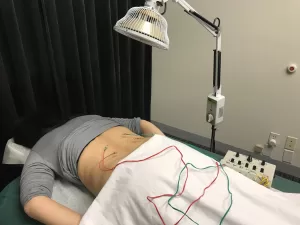-
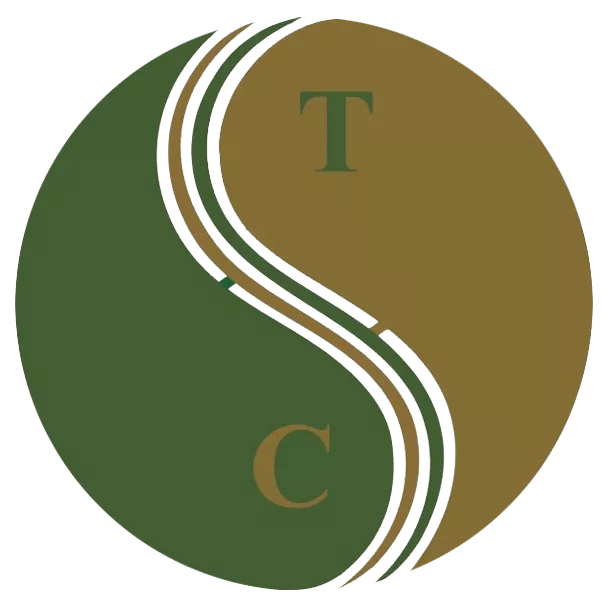 Art of Wellness Acupuncture & Traditional Chinese Medicine (TCM)11704 Wilshire Blvd, Suite 295, Los Angeles, CA, 90025
Art of Wellness Acupuncture & Traditional Chinese Medicine (TCM)11704 Wilshire Blvd, Suite 295, Los Angeles, CA, 90025
myartofwellness@gmail.com310-451-5522 Office Hours
MonClosedTue7:30 am --4 pmWed7:30 am --4 pmThu7:30 am -- 4 pmFri7:30 am -- 4 pmSat7:30 am -- 4 pmSunClosedOur office opens from Tuesdays to Saturdays 7:30 am to 4 pm, will be closed on Memorial day, Independent day, Labor day, Thanksgiving day, Christmas and New year.
-
Recent Posts
- How to Treat Rosacea With Acupuncture and TCM
- How to Treat Perioral Dermatitis With Acupuncture and TCM
- Lymphatic Drainage With Acupuncture and TCM
- How to Treat Turf Toe With Acupuncture
- How to Treat Nerve Pain With Acupuncture and TCM
- How to Treat Watery Eyes With Acupuncture and TCM
- How to Treat Ovarian Cysts With Acupuncture and TCM
- How to Treat Dystonia With Acupuncture and TCM
- Can Acupuncture Help Bad Breath?
- How to Treat Atopy with Acupuncture and TCM
- Plantar Fasciosis Treatment With Acupuncture and TCM
- How to Protect Yourself When Air Quality Is Poor
- How to Treat Spinal Headache With Acupuncture and TCM
- How to Treat Sarcoidosis With Acupuncture and TCM
- How to Treat Flu With Acupuncture and TCM
- Chinese New Year 2025 Year of the Snake
- Sign up to receive news and updates and get my free report:“The Top 10 Reasons to Try Acupuncture”

July 2025 M T W T F S S 1 2 3 4 5 6 7 8 9 10 11 12 13 14 15 16 17 18 19 20 21 22 23 24 25 26 27 28 29 30 31
Uncategorized
How to Treat Spinal Headache With Acupuncture and TCM
By Qineng Tan, L.Ac., Ph.D and Xiaomei Cai, L.Ac., Ph.D.
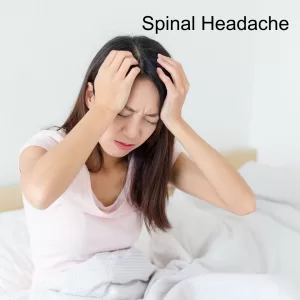
Bad headache that feels worse when you sit up and better when you lie down? Severe headache that lasts for days or weeks? This might be a spinal headache, also known as a post-dural headache or low CSF pressure headache. Acupuncture treatment and TCM remedies can help relieve the intense pain of a spinal headache.
What Is a Spinal Headache?
A spinal headache is a type of headache that can occur after medical procedures like a spinal tap (lumbar puncture) or an epidural block, often used during labor and delivery. These headaches are caused by a leak of cerebrospinal fluid (CSF), which leads to changes in pressure around the brain and spinal cord.
CSF surrounds the brain and spinal cord, providing cushioning and support, while also aiding in waste removal from the brain. If the fluid pressure drops—usually due to a tear in the protective meninges—the brain can sag downward when the individual is upright, leading to pain and other symptoms.
During a spinal tap or similar procedure, a needle is inserted into the fluid-filled space around the spinal cord. Occasionally, this puncture can cause spinal fluid to leak out.
When too much fluid escapes, it disrupts the pressure that cushions the brain and spinal cord, potentially leading to a spinal headache. This fluid leakage can cause stretching of the tissues around the brain and nerves that support it, sometimes resulting in the severe pain of a post-dural headache.
What Causes Low CSF Headache?
Common causes of CSF leaks include:
- Having a spinal tap procedure (lumbar punctures).
- Epidural during labor and delivery.
- Injuries to the meninges (the protective covering of the brain and spinal cord).
Spinal headaches affect 10% to 40% of people who undergo lumbar punctures or epidural anesthesia. The symptoms, such as severe, positional headaches, often resolve on their own, but they can last for days or even weeks in some cases.
Spinal Headache Symptoms

The most common symptom of a post-dural headache is positional pain. The headache is worse when you are standing or sitting upright and subsides when you are lying flat.
Typically absent when you wake up in the morning, symptoms often develop shortly after getting out of bed.
Other symptoms of low CSF headache include:
- Headache pain: Dull, throbbing, and worsened by sitting or standing; improved by lying down.
- Dizziness
- Tinnitus (ringing in the ears)
- Hearing loss
- Blurred or double vision
- Sensitivity to light
- Nausea
- Stiff neck
Treatment for Spinal Headache
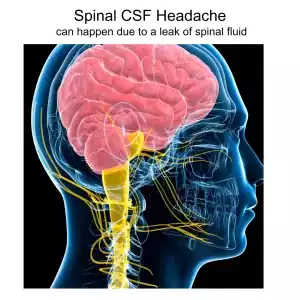
While many spinal headaches resolve on their own within a few days to two weeks, persistent cases may require treatment.
In Western medicine, spinal headaches are typically managed with simple measures such as rest, hydration, and over-the-counter pain relievers.
Fluids may be administered intravenously, to help restore CSF pressure.
Drinking caffeinated beverages, like coffee or tea, may be recommended, because caffeine constricts blood vessels and increases cerebrospinal fluid production.
Medications like gabapentin (used to treat nerve pain), hydrocortisone, or theophylline (which may help build more CSF may be prescribed if other remedies are ineffective.
When symptoms persist, more invasive treatments may be needed, such as an epidural blood patch. This procedure involves injecting a small amount of your own blood near the puncture site to seal the leak, offering rapid relief near the site of the leak to seal it. Another option is a glue injection: using X-ray guidance, doctors can seal leaks with medical glue.
In rare cases, surgery might be recommended.
While these methods are effective, they don’t address the underlying imbalances or promote the body’s self-healing capabilities in the way that acupuncture and TCM can.
Can Acupuncture Help Spinal Headache?
In Traditional Chinese Medicine, spinal headaches are not viewed as isolated conditions but as manifestations of deeper imbalances within the body.
TCM practitioners consider spinal headaches a type of head pain related to disruptions in the flow of Qi (energy) and Blood in the body.
Several TCM patterns may contribute to spinal headaches:
- Qi and Blood Deficiency: Weakness from CSF loss can lead to a deficiency of Qi and Blood, resulting in fatigue, dizziness, and headaches.
- Kidney Deficiency: The Kidney is closely related to the spine and brain in TCM. A deficiency in Kidney energy can cause spinal fluid imbalances.
- Liver Qi Stagnation: Stress and emotional strain may block the free flow of Qi, intensifying headache pain.
- Phlegm Obstruction: Excess fluids or “Phlegm” in TCM can block energy pathways, leading to dizziness, nausea, and heaviness in the head.

One clinical trial looked at 60 patients in three groups: one group received conventional care with pharmaceuticals for spinal headache, one group received acupuncture treatment, and one group received sham acupuncture (placebo).
The results for the patients who received acupuncture were similar to those who had been given medication and those who had been given acupuncture, while the placebo group had lower scores. This trial concluded that acupuncture was a good alternative to drugs for spinal headache pain.
Another case study followed 6 patients who were suffering from post-dural headaches after having given birth. All of them agreed to receive acupuncture treatment. Four of the patients got immediate relief after starting treatment. Two patients reported having some temporary relief, but then went on to have blood patch procedures.
Acupuncture Near Me for Spinal Headache
Even though a post-dural headache will usually go away on its own within days or weeks, it can seriously compromise a person’s well-being in the meantime. If you or a loved one is experiencing a low CSF headache, please do not hesitate to reach out to us at Art of Wellness Acupuncture in West L.A.. Doctors Tan and Cai have over three decades of experience helping patients find relief from severe headaches due to all kinds of causes.
*This article is for education from the perspective of Traditional Chinese Medicine only. The education provided by this article is not approved by FDA to diagnose, prevent, treat and cure human diseases. It should not stop you from consulting with your physician for your medical conditions. Traditional Chinese Medicine is based on Qi, which is an invisible force that usually cannot be observed by modern science. Because science focuses on testing ideas about the natural world with evidence obtained through observation, these aspects of acupuncture can’t be studied by science. Therefore acupuncture and Chinese herbs are often not supported by double-blind, randomized trials, and they are considered alternative medicine therapies in the United States.
How to Treat Sarcoidosis With Acupuncture and TCM
by Qineng Tan, L.Ac., Ph.D. and Xiaomei Cai, L.Ac., Ph.D.

Fever, fatigue, and muscle aches? Swollen lymph nodes, coughing, shortness of breath? Eye pain, or red eyes? These can all be signs of sarcoidosis, an autoimmune disorder. Acupuncture and TCM can help relieve sarcoidosis symptoms.
Sarcoidosis is a complex autoimmune disease characterized by the formation of granulomas—clumps of inflammatory cells—that can affect multiple organs in the body. It most commonly impacts the lungs and lymph nodes, but it can also involve the skin, eyes, heart, musculoskeletal system, and nervous system.
Sarcoidosis typically manifests in young adults, with the highest prevalence observed in individuals in their 20s and 30s, though it can affect people of any age. This condition’s exact cause remains unknown, but researchers believe it results from an overactive immune response to environmental or infectious triggers.
Sarcoidosis can cause serious and even life-threatening complications, especially when it is centered in the lungs. However, the good news is that many cases of sarcoidosis do eventually clear up or go into remission.
Acupuncture, herbs, and other TCM treatments for sarcoidosis can help address underlying issues that contribute to the formation of this autoimmune disorder, as well has help to relieve symptoms. TCM can also help with potential signs of dysautonomia (autonomic nervous system disorders) that can be caused by sarcoidosis.
Types of Sarcoidosis
There are different types of sarcoidosis depending on which organs are affected.
Pulmonary sarcoidosis, which targets the lungs, is the most common form and can lead to chronic respiratory issues.
Musculoskeletal sarcoidosis may cause joint inflammation (arthritis), muscle pain, or bone lesions, sometimes resulting in long-term complications such as osteoporosis.
Sarcoidosis can lead to vascular complications that involve inflammation of small, medium, or large blood vessels. These types of sarcoid-related vasculitis are rare but important to recognize, as they may present with overlapping features of other autoimmune or vascular conditions.
Small-vessel vasculitis in sarcoidosis primarily affects the skin. This type of vasculitis might coexist with sarcoidosis and manifests as petechiae (small red or purple spots on the skin), purpuric spots (purple “blood spots” under the skin, due to broken blood vessels), or infiltrative erythema (raised rash, like welts on skin).
Medium-vessel sarcoid vasculitis often involves pulmonary lymphatic capillaries and may present with systemic symptoms, including fever, arthritis, and cutaneous manifestations (skin rash or lesions).
Sarcoidosis symptoms can vary widely but may include persistent fatigue, fever, shortness of breath, coughing, swollen lymph nodes, and joint pain. Because of its wide range of manifestations, sarcoidosis can be difficult to diagnose and often requires imaging tests, biopsies, and bloodwork.
New Diagnostic Methods for Sarcoidosis
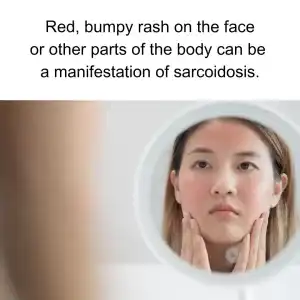
Diagnosing sarcoidosis remains a complex challenge for clinicians because there is no single definitive test for the disease. The diagnosis is often made by combining a thorough clinical evaluation, imaging studies, laboratory tests, and biopsy results. However, emerging research has identified new biomarkers that may help streamline the diagnostic process.
One promising development involves the discovery of type 1 innate lymphoid cells (ILC1) as a potential biomarker for sarcoidosis. A study led by researchers at the University of Pennsylvania compared skin samples from sarcoidosis patients to those with granulomas caused by other conditions. They found that levels of ILC1 were significantly higher in sarcoidosis-affected tissues. This trend was also observed in lung granulomas and even in the bloodstream, where sarcoidosis patients showed a 12-fold increase in circulating ILC1 levels compared to healthy individuals.
Sarcoidosis Treatment
The main goals of treatment for sarcoidosis are managing symptoms, reducing the risk of organ damage, and improving the patient’s quality of life. In some cases, sarcoidosis may go into remission, meaning that the condition is no longer causing complications.
Patients with mild or no symptoms might not require treatment, just monitoring. When treatment is necessary, Western medicine focuses on reducing inflammation and suppressing the overactive immune system. These treatments can be highly effective but often come with potential risks and side effects.
Prednisone is usually the first-line treatment for sarcoidosis. This steroid medication suppresses the immune system and reduces inflammation, which can help to improve symptoms and prevent organ damage. However, long-term use of prednisone may lead to significant side effects, such as weight gain, bone loss, high blood sugar, and an increased risk of infection. For this reason, corticosteroid doses are typically tapered once symptoms improve, or alternative medications may be introduced to minimize steroid use.
Methotrexate, a drug commonly used for severe rheumatoid arthritis, is another option for managing sarcoidosis. It is particularly effective in patients with significant organ involvement, such as lung, skin, or joint manifestations. Methotrexate helps to suppress the immune system and can be used in combination with corticosteroids to reduce the need for higher steroid doses.
Drugs such as hydroxychloroquine, which are typically used to treat malaria, can be effective for sarcoidosis that primarily affects the skin or joints. These medications may also be helpful for managing chronic fatigue and muscle pain associated with the condition.
Tumor necrosis factor (TNF) inhibitors, like infliximab or adalimumab, are biologic medications that help reduce inflammation. These drugs are often used in patients with severe sarcoidosis, particularly when other treatments have not been effective. TNF inhibitors can be administered intravenously or as an injection under the skin.
Corticotropin is a medication that stimulates the adrenal glands to produce natural steroid hormones. It can be injected under the skin to help manage inflammation and reduce immune system activity, offering an alternative to synthetic corticosteroids.
Acupuncture and other TCM treatments can be helpful for clearing inflammation and relieving symptoms related to sarcoidosis, as well as helping to manage the side effects that may be caused by other medications.
Can Acupuncture Help Sarcoidosis?
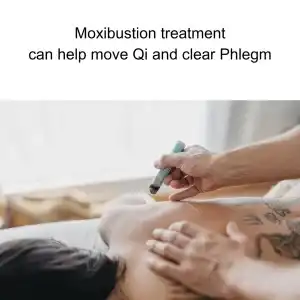
In TCM, sarcoidosis is viewed as a condition arising from underlying imbalances in the body. These imbalances are often associated with heat, phlegm, and stagnation of Qi and blood. Granulomas, for example, may be interpreted as accumulations of dampness and phlegm obstructing the free flow of Qi and blood. Furthermore, the systemic inflammation seen in sarcoidosis can be attributed to excessive heat in the body. TCM practitioners focus on identifying the root causes of these imbalances and tailoring treatments to the individual’s unique presentation.
Acupuncture treatments for sarcoidosis aim to reduce inflammation, support the immune system, and restore balance within the body. By stimulating specific acupuncture points, practitioners can promote the smooth flow of Qi and blood, reduce stagnation, and clear heat and dampness. This can help alleviate symptoms such as shortness of breath, fatigue, and joint pain, which are commonly experienced by those with sarcoidosis.
Research has shown that acupuncture can help modulate the immune system, reduce stress, and improve quality of life for people with chronic inflammatory conditions. For sarcoidosis patients, regular acupuncture sessions may not only provide symptom relief but also address the underlying imbalances contributing to the disease.
Chinese Medicine diagnosis is different from Western medicine diagnosis. An acupuncture practitioner will look carefully at each individual patient’s specific symptoms, medical history, and foundational constitution to discover the underlying causes of their particular presentation of disease.
In the case of sarcoidosis, possible TCM diagnoses might be:
- Lung Qi Deficiency – presents with symptoms like shortness of breath, weak lung sounds, throat rattling, spontaneous sweating, feeling cold, pale complexion, weak voice. Treatment will seek to tonify Lung Qi to strengthen respiratory function possibly with the inclusion of moxibustion treatment.
- Lung Yin Deficiency – symptoms: breathlessness, night sweats, 5-center heat (warmth in palms, soles, and chest), dry throat, non-productive cough, malar flush, red skin lesions. Treatment goals include nourishing Lung Yin and clearing heat.
- Lung Qi Stagnation – symptoms: chest congestion/blockage, difficulty breathing, emotional grief or melancholy, trouble letting go of the past, and constipation. Treatment will help improve circulation of Lung Qi to relieve stagnation and promote emotional well-being.
- Phlegm in the Lungs- symptoms: Chronic phlegm retention contributing to fibrous tissue and scarring, which can parallel conditions such as chronic bronchitis. There may also be phlegm-related symptoms like congestion or rattling breath. Treatment will seek to nourish Lung Qi, transform phlegm, and circulate Qi to reduce stagnation.
These differential diagnoses reflect the diverse ways in which TCM approaches pulmonary dysfunctions and can be used to tailor treatments for individuals with sarcoidosis, ensuring that the root causes and symptoms are addressed holistically.
Acupuncture for Sarcoidosis Near Me in West Los Angeles
If you or someone you know is suffering with sarcoidosis, or perhaps has some of the symptoms mentioned above, but has not been able to get adequate diagnosis or treatment for their condition, it may be appropriate to seek care from a qualified TCM doctor. Dr. Tan and Dr. Cai at Art of Wellness in Los Angeles, just east of Santa Monica, have over 35 years of experience helping people with all types of autoimmune disorders, skin conditions, respiratory problems, and musculoskeletal pain. We can help you find relief and better health.
*This article is for education from the perspective of Traditional Chinese Medicine only. The education provided by this article is not approved by FDA to diagnose, prevent, treat and cure human diseases. It should not stop you from consulting with your physician for your medical conditions. Traditional Chinese Medicine is based on Qi, which is an invisible force that usually cannot be observed by modern science. Because science focuses on testing ideas about the natural world with evidence obtained through observation, these aspects of acupuncture can’t be studied by science. Therefore acupuncture and Chinese herbs are often not supported by double-blind, randomized trials, and they are considered alternative medicine therapies in the United States.
How to Treat Flu With Acupuncture and TCM
By Xiaomei Cai, L.Ac., Ph.D. and Qineng Tan, L.Ac., Ph.D.
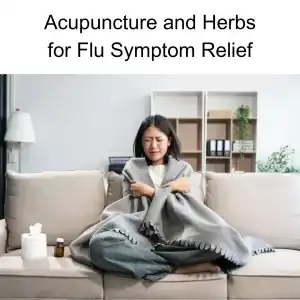
Coughing, fatigue, body aches, fever? The flu often comes on more suddenly and intensely than a common cold. Acupuncture and Traditional Chinese Medicine (TCM) offer holistic treatment for the flu, alleviating flu symptoms, strengthening the immune system, and helping your body recover faster and avoid complications.
What Is the Flu?
Influenza, or “the flu,” is a viral infection that targets the respiratory system. Caused by various strains of the influenza virus, the flu spreads easily through respiratory droplets when someone sneezes, coughs, or talks, or by touching contaminated surfaces and then touching your mouth, nose, or eyes.
Unlike the common cold, the flu can lead to complications like sinus infections, bronchitis, or pneumonia, especially for children, older adults, pregnant individuals, and people with chronic health conditions.
Flu symptoms generally last 5–7 days, but fatigue and weakness may linger for weeks. Complications like pneumonia, bronchitis, or worsening of chronic conditions can occur, making proper care and recovery essential.
Acupuncture treatment and traditional Chinese herbal remedies can help make you feel more comfortable, fight off the virus, shorten the duration of the flu, and help prevent further complications, like pneumonia.
Top 10 Flu Symptoms
While flu symptoms can vary, they are typically more intense than those of a cold. Common flu symptoms include:
- High fever (usually above 100°F/37.8°C)
- Chills and sweating
- Severe fatigue
- Body aches and muscle pain
- Headache
- Dry, persistent cough
- Sore throat
- Runny or stuffy nose
- Shortness of breath or chest discomfort
- Nausea, vomiting, or diarrhea (more common in children)
The flu’s systemic effects, such as body aches and fever, set it apart from the cold, which tends to stay localized in the nose and throat.
Conventional Flu Treatment

When most people experience flu symptoms, they usually turn to over-the-counter (OTC) remedies to manage discomfort and speed recovery. Common options include pain relievers like acetaminophen or ibuprofen to reduce fever, body aches, and headaches. Decongestants such as pseudoephedrine can help alleviate nasal congestion, while antihistamines may reduce runny nose and sneezing. Cough suppressants and expectorants are frequently used for managing cough symptoms. These remedies do not treat the flu virus itself but aim to ease symptoms and improve comfort during recovery.
When consulting a medical doctor, the advice may differ based on the severity of symptoms and the patient’s health history. Doctors typically recommend rest, plenty of fluids, and fever management with OTC medications. For higher-risk patients, such as the elderly, young children, or those with underlying conditions, a physician may prescribe antiviral medications like oseltamivir (Tamiflu) or baloxavir (Xofluza). These antivirals work best when started within 48 hours of symptom onset and may help reduce the duration and severity of the flu. Doctors may also advise preventive measures such as flu vaccines to reduce the likelihood of severe flu symptoms in the future.
How TCM and Acupuncture View and Treat the Flu
In Traditional Chinese Medicine (TCM), the flu is understood as an invasion of external pathogens, which disrupt the body’s internal balance. These pathogens are categorized by patterns that describe the nature of the illness and its symptoms.
For the flu, the two most common TCM diagnostic patterns are:
Wind-Cold Flu: Symptoms include chills, body aches, mild fever, and a runny nose with clear mucus. This type of flu often makes you feel cold and tired. Treatment in TCM focuses on dispersing wind and cold, warming the body, and alleviating muscle aches.
Wind-Heat Flu: Symptoms include a high fever, sore throat, cough, and yellow mucus. People with wind-heat flu may feel hot, irritable, and experience dryness or redness in the throat and nasal passages. Treatment focuses on clearing heat, reducing inflammation, and supporting the body’s ability to heal.
In TCM, the flu is not seen as a single illness but as a dynamic condition unique to the individual. Acupuncture treatment for the flu aims to restore balance by addressing the specific pattern of symptoms and supporting the immune system.
An acupuncturist will treat you with an individualized treatment plan, including acupuncture points and herbs to help relieve specific symptoms and address underlying conditions.
Can Acupuncture Help the Flu?
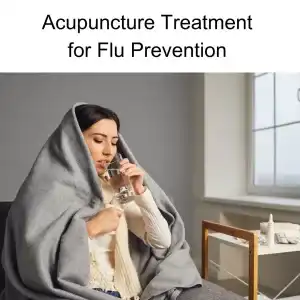
Acupuncture helps to boost the immune system and relieve symptoms like body aches, congestion, and fever by stimulating specific points that regulate the body’s energy (Qi).
Acupuncture is a safe and natural way to support the body during and after the flu. Specific acupuncture points are used to target the symptoms and promote faster recovery by relieving nasal congestion and sinus pressure. Points on the face and head can help open the nasal passages and reduce sinus pain.
Acupuncture helps improve blood circulation and relax the muscles to ease body aches and discomfort. Points along the lung and throat meridians can help relieve dryness, inflammation, and coughing.
In addition to acupuncture, herbal medicine is often used to support the body during flu recovery. Herbal formulas like Yin Qiao San or Gan Mao Ling are commonly prescribed to address early-stage flu symptoms, such as sore throat and fever. Other remedies, like ginger tea or custom herbal combinations, may be recommended based on the individual’s specific needs and flu pattern.
Preventing the Flu with Acupuncture and TCM
The best way to avoid the flu is to strengthen your immune system before flu season hits. TCM emphasizes maintaining balance in the body through regular acupuncture treatments, seasonal herbal formulas, and healthy lifestyle habits. Diet, sleep, and stress management are also key components of flu prevention in TCM. Foods like warming soups, ginger, garlic, and green vegetables can help nourish the body and support immunity.
Traditional Chinese Medicine (TCM) has demonstrated significant promise in the prevention and treatment of influenza through various mechanisms, including antiviral effects, immune modulation, and anti-inflammatory properties. Classical TCM prescriptions incorporate combinations of herbs that target both the virus and the host’s immune response.
TCM contributes to indirect antiviral activity by regulating the host immune system. Studies reveal that herbal prescriptions like Sheng Jiang San (SJS) and Yinqiao powder help modulate cytokine activity, which is associated with lung inflammation in influenza.
TCM approaches flu treatment through a dual action: directly targeting the virus and enhancing the host’s immune defenses while controlling inflammation.
Getting regular acupuncture treatments and taking your herbal formula is one of the best ways to prevent flu and the common cold.
Acupuncture Near Me for Flu Relief in Santa Monica and West LA
Whether you’re dealing with the flu or looking for preventative care during flu season, acupuncture and TCM offer a natural, effective approach to health and wellness. At Art of Wellness, our experienced practitioners tailor treatments to address your unique symptoms and help your body recover faster. Contact us today to learn more about how we can support your health through every season.
*This article is for education from the perspective of Traditional Chinese Medicine only. The education provided by this article is not approved by FDA to diagnose, prevent, treat and cure human diseases. It should not stop you from consulting with your physician for your medical conditions. Traditional Chinese Medicine is based on Qi, which is an invisible force that usually cannot be observed by modern science. Because science focuses on testing ideas about the natural world with evidence obtained through observation, these aspects of acupuncture can’t be studied by science. Therefore acupuncture and Chinese herbs are often not supported by double-blind, randomized trials, and they are considered alternative medicine therapies in the United States.
Chinese New Year 2025 Year of the Snake
By Qineng Tan, L.Ac., Ph.D. and Xiaomei Cai, L.Ac., Ph.D.
Chinese New Year 2025: Year of the Wood Snake
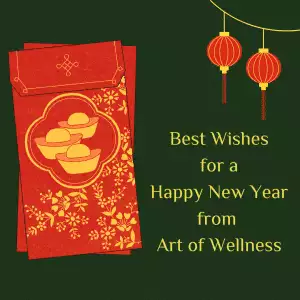
The Lunar New Year begins on January 29, 2025, and with it comes the Year of the Snake! As we transition from the dynamic Year of the Dragon 2024 to the mysterious and intuitive Snake Year, we can expect a shift in energy. While the Dragon represents bold and external action, the Snake encourages introspection, wisdom, and transformation. Expect changes on the horizon, for the world at large, and for you, as an individual, in the Snake Year.
Chinese Zodiac 2025
The Chinese Zodiac, like the Western Zodiac, cycles through twelve animals, with each animal representing one year in a twelve-year cycle. In addition, the Chinese astrological system incorporates the five elements—Wood, Water, Metal, Earth, and Fire—which rotate alongside the zodiac animals. 2025 will be the Year of the Wood Snake, emphasizing growth, creativity, and flexibility.
Every 12 years, there will be the return of an animal sign, but it is a 60 year cycle before the sign appears with the same element. Thus, the last time that it was the year of the Wood Snake was in 1965.
The Snake is associated with intuition, mystery, and wisdom. People born under the Snake sign are often seen as deep thinkers, strategic planners, and naturally charming. The Wood element enhances the Snake’s ability to adapt and brings a softer, more nurturing quality to its otherwise intense and focused energy. This makes 2025 a year to cultivate patience, pursue self-improvement, and seek balance in all areas of life.
What Is My Chinese Zodiac Sign?
To find your Chinese zodiac sign, look for your birth year below (if your birthday falls in January or February, double-check as the Lunar New Year varies):
Snake: 1941, 1953, 1965, 1977, 1989, 2001, 2013, 2025
Horse: 1942, 1954, 1966, 1978, 1990, 2002, 2014
Goat: 1943, 1955, 1967, 1979, 1991, 2003, 2015
Monkey: 1944, 1956, 1968, 1980, 1992, 2004, 2016
Rooster: 1945, 1957, 1969, 1981, 1993, 2005, 2017
Dog: 1946, 1958, 1970, 1982, 1994, 2006, 2018
Pig: 1947, 1959, 1971, 1983, 1995, 2007, 2019
Rat: 1936, 1948, 1960, 1972, 1984, 1996, 2008, 2020
Ox: 1937, 1949, 1961, 1973, 1985, 1997, 2009, 2021
Tiger: 1938, 1950, 1962, 1974, 1986, 1998, 2010, 2022
Rabbit: 1939, 1951, 1963, 1975, 1987, 1999, 2011, 2023
Dragon: 1940, 1952, 1964, 1976, 1988, 2000, 2012, 2024
Year of the Snake Horoscope

While the Dragon inspires bold moves, the Snake is known for its ability to pause and evaluate before acting. In 2025, you may find yourself encouraged to slow down, assess long-term goals, and focus on inner growth. The Snake’s association with transformation means this year could bring opportunities for personal or professional reinvention.
Top 3 Personality Traits of the Snake
People born in the year of the snake might seem casual and nonchalant, but under the surface, they are always thinking deeply and taking things quite seriously. They are great at making detailed plans, setting goals, and solving problems. On the negative side, the Snake may tend to gossip, gathering information about people and using it to manipulate the situation.
- Strategic and Thoughtful: Snakes take the time to think through problems and are deliberate in their actions, relying on their sharp intuition to make decisions. In fact, it may be difficult for the Snake to stop over-thinking.
- Charming but Reserved: While Snakes are social, they can be guarded about revealing their true selves. The snake is quite independent, and can hide in stillness for long periods of time before moving quickly to act. If the snake has a weakness, it may be that it can be suspicious of others and therefore rely on its own judgement too much.
- Resilient and Mysterious: Snakes possess a quiet strength and are drawn to uncovering life’s deeper truths.
Best Wellness Tips for 2025
The Snake’s introspective energy is an excellent reminder to care for both your mental and physical health. This year may be the perfect time to explore practices that promote mindfulness, such as meditation or acupuncture. Strengthen your resilience by supporting your immune system and prioritizing balance in all aspects of life.
Chinese New Year Traditions: Preparing for the Year of the Snake
The Lunar New Year is a time for celebration, reflection, and preparation. Traditional activities include:
- Cleaning Your Home: A thorough cleaning before the New Year sweeps away bad luck and makes room for positive energy.
- Wearing Lucky Colors: The Snake’s lucky colors include green, black, and yellow. Incorporating these hues into your wardrobe or home décor can enhance harmony and luck.
- Giving Red Envelopes: Red envelopes filled with money symbolize good fortune and are a beloved tradition of Lunar New Year celebrations.
Feng Shui for 2025

To align with the Snake’s energy, focus on creating a serene and organized environment. Declutter your space and add natural elements like plants or wood accents to harness the creative energy of the Wood Snake. Incorporating calming symbols, such as the Snake itself, can further enhance a sense of peace and protection.
Bringing in new house plants is a wonderful way to welcome new energy and prosperity into your home. Great choices as lucky plants for 2025 include:
- Bamboo plant
- Lemon tree or orange tree
- Succulents with round, full leaves
- Jade plants
- Basil plants
Acupuncture & TCM for the Year of the Snake
The Snake’s connection to transformation and healing aligns closely with the principles of Traditional Chinese Medicine (TCM). In TCM, the Snake symbolizes regeneration, as snakes shed their skin to grow. This year is an ideal time to focus on preventive care and balance through acupuncture, herbal medicine, and mindful living.
Whether you’re seeking relief from stress, boosting your immunity, or resetting your body’s energy, acupuncture can be an invaluable tool in 2025.
Happy New Year from Art of Wellness
As we move into the Year of the Snake, it’s time to nurture your inner wisdom and embrace the opportunity for personal growth. From all of us at Art of Wellness, we wish you health, happiness, and harmony in 2025.
“岁岁平安!” — Peace and safety year after year!


